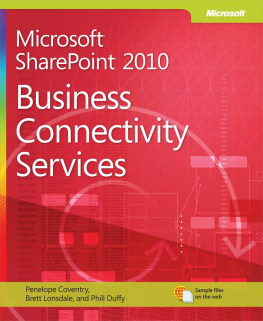Microsoft SharePoint 2013: Planning for Adoption and Governance
Geoff Evelyn
Published by Microsoft Press
Special Upgrade Offer
If you purchased this ebook directly from oreilly.com, you have the following benefits:
DRM-free ebooksuse your ebooks across devices without restrictions or limitations
Multiple formatsuse on your laptop, tablet, or phone
Lifetime access, with free updates
Dropbox syncingyour files, anywhere
If you purchased this ebook from another retailer, you can upgrade your ebook to take advantage of all these benefits for just $4.99. to access your ebook upgrade.
Please note that upgrade offers are not available from sample content.
Introduction
Microsoft SharePoint is a strategic business platform that allows people to connect seamlessly with each other in terms of centralized content management. Furthermore, as a collaborative tool, SharePoint can be used by anyone, and can be installed and configured very quickly.
The simplicity of provisioning SharePoint in this way, however, leads to issues where a business does not have the opportunity to define a SharePoint strategy, because it might not be aware there are practical and structured techniques for building, managing, and delivering SharePoint solutions. This lack of information is also compounded because SharePoint may have been provisioned through an IT project, with little to no business interaction. In IT projects, service delivery is not often seen as a priority. This often leads to issues concerning ownership, which can negatively affect User Adoption. Therefore, without the business taking ownership of the SharePoint solutions, the result is usually failures with regards to User Adoption, Governance, training, and communications.
Service delivery encompasses User Adoption and Governance
Successful SharePoint service delivery means understanding, defining, and maintaining business ownership of SharePoint solutions. Through service delivery processes, you will be able to do the following:
Define the content of services clearly
Define the roles and responsibilities of customers (those who pay for the services), users, and service providers clearly
Set expectations of service quality, availability, and timeliness
Sustain User Adoption and Governance
In my years spent working in SharePoint service delivery, I have witnessed and been a part of SharePoint delivery successes and failures. Some of these failures were due to the business not being able to convince their audience of the value of SharePoint solutions; others were due to User Adoption or training strategies not being included as part of providing a SharePoint solution.
The success of any SharePoint solution relies on a successful User Adoption strategy. User Adoption involves a cultural shift because there may be changes to the processes and procedures that people use when a new SharePoint solution is being provided. And those changes are supposed to improve user productivity and increase return on investment (ROI), or there would be no point in providing the SharePoint solution. However, User Adoption is not simply a technical transition from one system or process into a new system or process. The success of User Adoption is measured by the ability of the users being able to use the replacement comfortably. The replacement system must be governed and supported, meaning that User Adoption, Governance, and support must be sustained throughout the lifetime of the replacement (which is called a SharePoint solution in this book).
Successful User Adoption requires a sequenced set of events to work; for example, the creation of a delivery program that encompasses the creation of a SharePoint solution and will include various projects to create a service delivery model: Governance, policy, User Adoption, training, administration, and licensing. Therefore, a phased approach is required.
User Adoption is the key to ROI with SharePoint. Achieving results requires an approach for gaining executive sponsorship and user buy-in. Strong User Adoption goes beyond traditional change management, and you should never underestimate the impact that User Adoption can have on any SharePoint solutions provided.
Essentially, in order for User Adoption to work, you need to consider how SharePoint is going to be provided to the customers. While these are covered in detail in the book, here is a summary of the required points:
Carry out customer intelligence. You must truly define the customer base. Identify the SharePoint sponsor, the stakeholders, and the user audience. Identity what they need and expect from the SharePoint delivery team. Ensure that you can provide a way to measure how the delivery team is doing in meeting customer requirements.
Value your SharePoint support services. The key to delivering great service is people, not the organization. Some SharePoint support services are delivered by empowering their support team to be proactive and be flexible.
Understand how customers think. Part of a method in sustaining User Adoption is to test for the emotional elements of the user experience concerning using SharePoint. Proactively surveying users means plugging into their experiences and resolving issues before the relationship between the customer and those providing the solution to the customer breaks down.
Ensure that your SharePoint sponsor believes in SharePoint service delivery. If the SharePoint sponsor does not believe in service excellence, it wont happen. The SharePoint sponsor needs to take service delivery seriously.
Ensure that User Adoption strategy is aligned with SharePoint support. SharePoint support excellence is a function of how the organization is designed. Its key elements shape the user experience, and its effectiveness influences the success of User Adoption. This is particularly obvious in the area of customer complaints. How are complaints handled? Are they treated as a priority and sorted according to urgency, or are they chucked in a pile, to be dealt with as and when possible?
Make a concrete link to the bottom line. Good SharePoint service delivery ensures that users who have a great experience are more likely to continue to use SharePoint and more likely to recommend SharePoint to others.
Improve services continually. Sustained User Adoption and Governance come from managing training models, which in turn drives user continuous improvement. Do not settle for a set level of service, even if you think its good. Even if users are satisfied with service, maybe it could still be improved.
Understand that the future will be different. Technology is changing the way that service is delivered all the time. Failing to grasp the opportunities and threats presented by this inevitability could lead to failure.
Learn from your mistakes. Everybody makes mistakes, but winners learn from them. Advocate a willingness to change and develop your service delivery strategies based on feedback from your users.
Make things easier for customers. Continually use communication channels and User Adoption tactics to identify agile, flexible solutions. Create structured delivery plans so that you do not present unclear pricing, long delivery times, insufficient information, and poor support and service.










